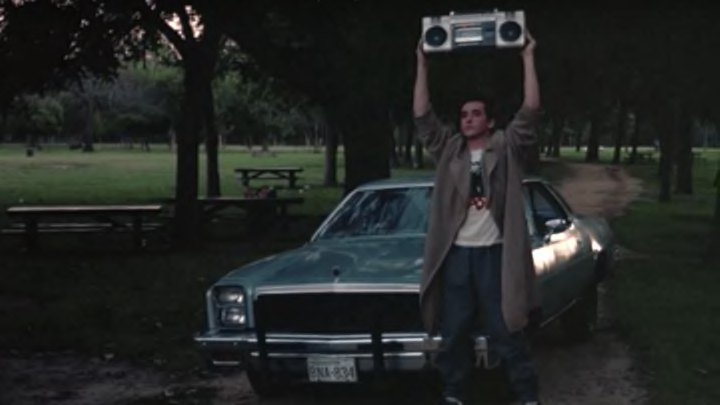Cameron Crowe was puzzled. The writer and first-time director had submitted a cut of his new film, Say Anything..., to musician Peter Gabriel in the hopes that Gabriel would be willing to license his song for the now-classic scene where Lloyd Dobler (John Cusack) holds a boombox over his head to signal to love interest Diane Court (Ione Skye) that he wasn’t giving up on their relationship.
Crowe knew Gabriel was a hard sell when it came to allowing use of his music, but his reason for not wanting to allow it in the case of Say Anything... was odd. Gabriel called Crowe to tell him he didn’t feel the song was a fit because of “the overdose” in the movie.
Say Anything... had no overdose scene.
It turns out that Gabriel had called Crowe believing he had something to do with Wired, the biopic about late comedian John Belushi that had also been requesting to use “In Your Eyes.” After Crowe corrected him, Gabriel watched the correct tape and gave the director permission to use the song. It would be one of many obstacles in committing a seemingly simple scene to movie history.
Released in 1989, Say Anything... was Crowe’s irreverent take on the teenage romance genre, a format that had been claimed by John Hughes for much of the 1980s. Instead of an idealized male lead, Crowe was more interested in aspiring kickboxer Dobler acknowledging he was a poor social and class fit for Court, who seemed to have a secure future as an intellectual. Instead of a woman looking up at her crush, it was Dobler who was presenting himself as full of doubt that he was good enough.
That characterization worked for the film right up until it was time to shoot the boombox scene, which follows Court breaking up with Dobler and giving him a pen. (“I gave her my heart and she gave me a pen,” Dobler sighs.) Crowe thought Dobler would want a signal flare of sorts to let Court know he wasn’t giving up hope. For the director, who started writing profiles for Rolling Stone at age 15, music seemed like the way to go.
But Dobler’s seeming subservience made Cusack reluctant. He felt holding the boombox over his head outside Court’s house was too much groveling—and Dobler, despite his self-awareness, was more of a dogged pursuer than a pathetic one.
To placate Cusack, Crowe tried shooting the scene with Dobler idling in the car while the boombox sat on the roof. It didn’t work: Dobler was now too passive, too disinterested. The scene, which Crowe and producer James L. Brooks believed could become a hallmark of the movie, was going to have to be abandoned.
On the last day of shooting in Los Angeles, Crowe and his crew spotted an empty park. Daylight was running out and there wasn’t much time left. Crowe convinced Cusack to try the scene the way he had originally envisioned it, with Dobler holding the boombox over his head. This time, Cusack knew how to play it.
With Fishbone's "Turn the Other Way" blaring from the speakers on set, Cusack and Crowe made the shot work for them by agreeing to show a look of defiance, not defeat, on his face. Cusack would later recall that it was really Dobler’s “final stand” as Court’s romantic interest. That perspective allowed him to give Dobler his moment without betraying the character.
During editing, Crowe decided Fishbone wasn’t working for the moment. “In Your Eyes” played during Crowe’s wedding, and while listening to a tape of music from the reception, he realized it was perfect for the scene. After clearing up the confusion with Gabriel, he convinced 20th Century Fox to pony up between $200,000 and $300,000 for the rights to the song.
Say Anything was released on April 14, 1989; a quiet and introspective movie, just before the assault of big summer releases like Batman and Lethal Weapon 2. While it was a modest success during its initial run, it has since become a cult classic, with the boombox scene being one of the most iconic courting scenes in the history of filmed romance.
Although Cusack played the scene the way he wanted, it doesn’t appear as if he has ever been entirely comfortable with any attempts to pay homage to it. Stepping on stage for a Gabriel concert in 2012, he handed a boombox to Gabriel, who held it up himself rather than have Cusack do it. And in a 2009 MTV interview, Cusack appeared to recoil at the sight of a cardboard boombox brought along by an interviewer. “No, no, no, no, no, no, no,” he said. “I don’t have to do anything with this, right?”
